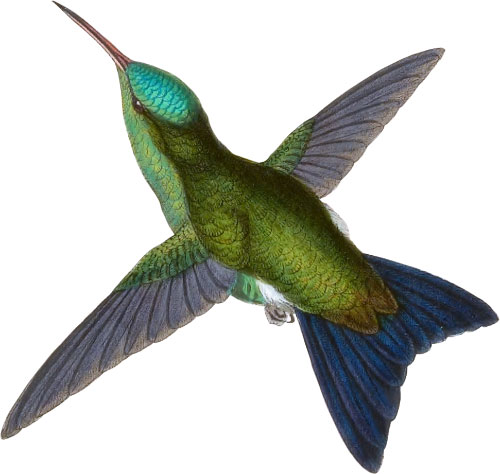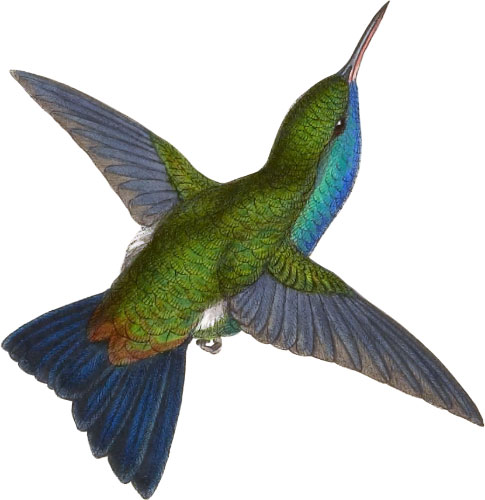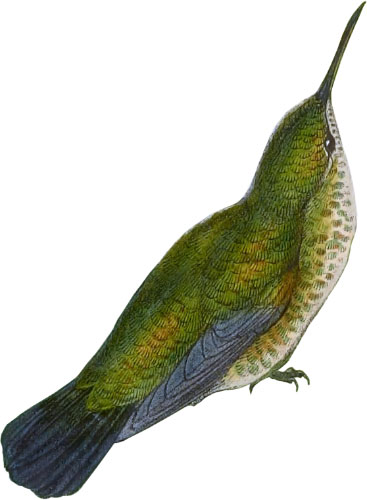Reeve’s Sapphire
South-eastern Brazil
Among the numerous persons whose acquaintance and friendship I have had the pleasure of making during the progress of the present work, no one is more highly valued by me than Mr. Thomas Reeves of Rio de Janeiro, a gentleman who has at all times most liberally furnished me with whatever information he could acquire respecting the species inhabiting Brazil, and moreover enriched my collection with some species I could not have procured elsewhere; among which must be enumerated a very fine example of the bird figured on the annexed Plate.
This new and interesting bird Mr. Reeves informs me is found at St. Paul’s, and this unfortunately is all that he is enabled to tell me respecting it. This example is the only one I have seen.
The Eucephala cæruleo-lavata is a stout and rather large species for a Humming-Bird, and differs widely from every other that has come under my notice; in its proportions it may be said to be perfect 5 its bill being moderate in size, and its tail, which is slightly forked, well balanced when compared with its body and wings; for its colouring I must refer my readers to the accompanying figures and the following detailed description.
I am not quite satisfied that a place in the genus Eucephala is the proper position for this bird among the Trochilidæ, and I feel that I might, without overstepping the bounds of propriety, have constituted it the type of a new genus.
Crown of the head greenish blue, not very brilliant, but having a few conspicuous small bright-blue feathers intermingled; throat and chest bright greenish blue, passing into purer green on the flanks; back of the neck, and back, deep grass-green; wings purplish brown; upper tail-coverts bronzy orange; under tailcoverts bronzy purplish brown; two middle tail-feathers deep purplish bronze; the next on each side is washed with bronze on its outer margin; the remaining feathers purplish black; thighs greyish white; the bill appears to have been reddish flesh-colour at the base of both mandibles and black at the tip.
The figures are of the natural size. The plant is the Nematanthus ionæma.
 Eucephala Grayi
Blue-headed Sapphire
Eucephala Grayi
Blue-headed Sapphire
 Eucephala smaragdo-cærulea
Green and Blue Sapphire
Eucephala smaragdo-cærulea
Green and Blue Sapphire
 Eucephala chlorocephala
Green-headed Sapphire
Eucephala chlorocephala
Green-headed Sapphire
 Eucephala hypocyanea
Blue-breasted Sapphire
Eucephala hypocyanea
Blue-breasted Sapphire
 Eucephala cærulea
Blue-chinned Sapphire
Eucephala cærulea
Blue-chinned Sapphire
 Eucephala scapulata
Black-bellied Sapphire
Eucephala scapulata
Black-bellied Sapphire
 Eucephala pyropygia
Fire-rumped Sapphire
Eucephala pyropygia
Fire-rumped Sapphire
 Eucephala subcærulea
Blue-breasted Sapphire
Eucephala subcærulea
Blue-breasted Sapphire
 Eucephala cyanogenys
Blue-faced Sapphire
Eucephala cyanogenys
Blue-faced Sapphire
Featuring all 422 illustrated species from John Gould’s A Monograph of the Trochilidæ, or Family of Humming-Birds arranged by color.